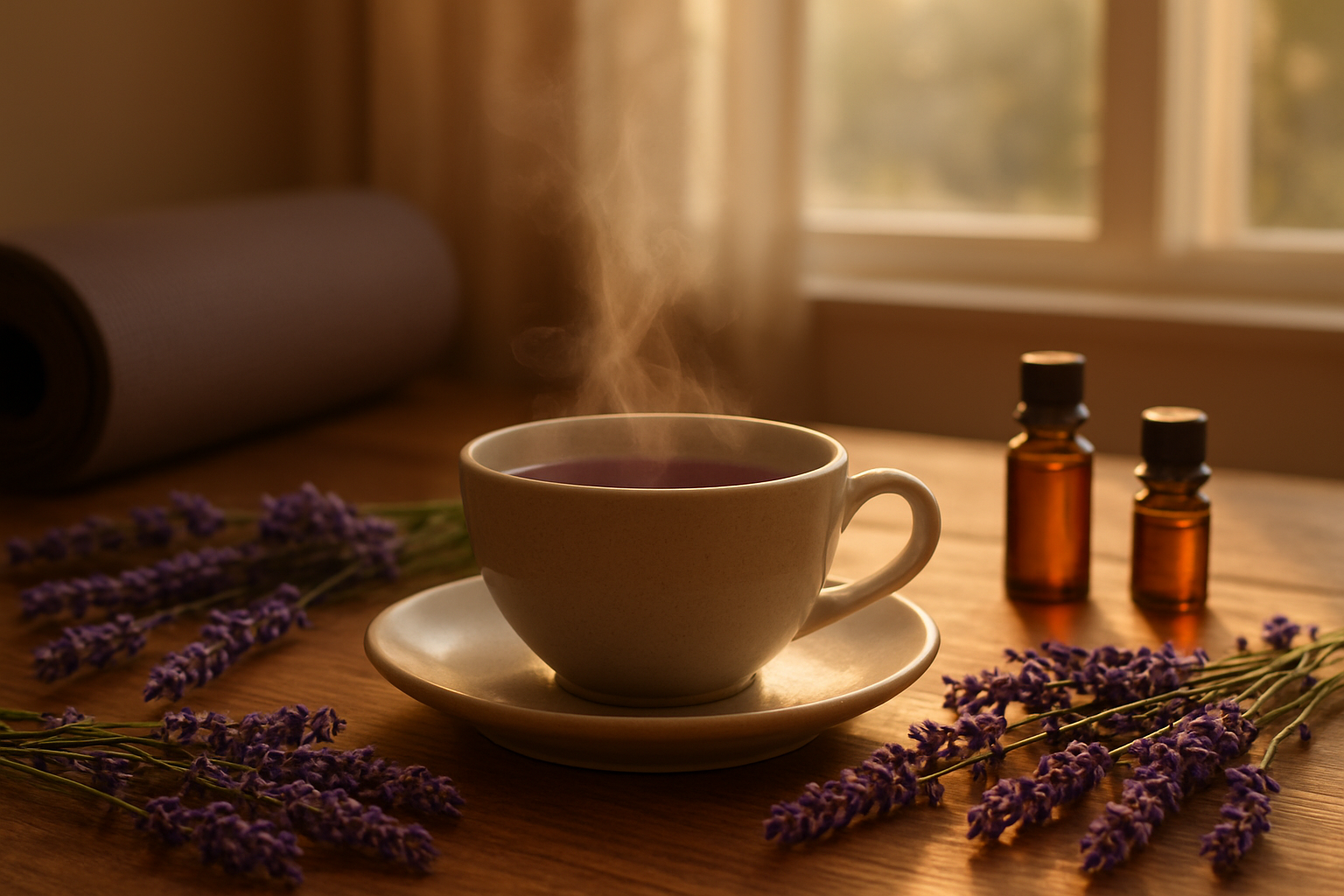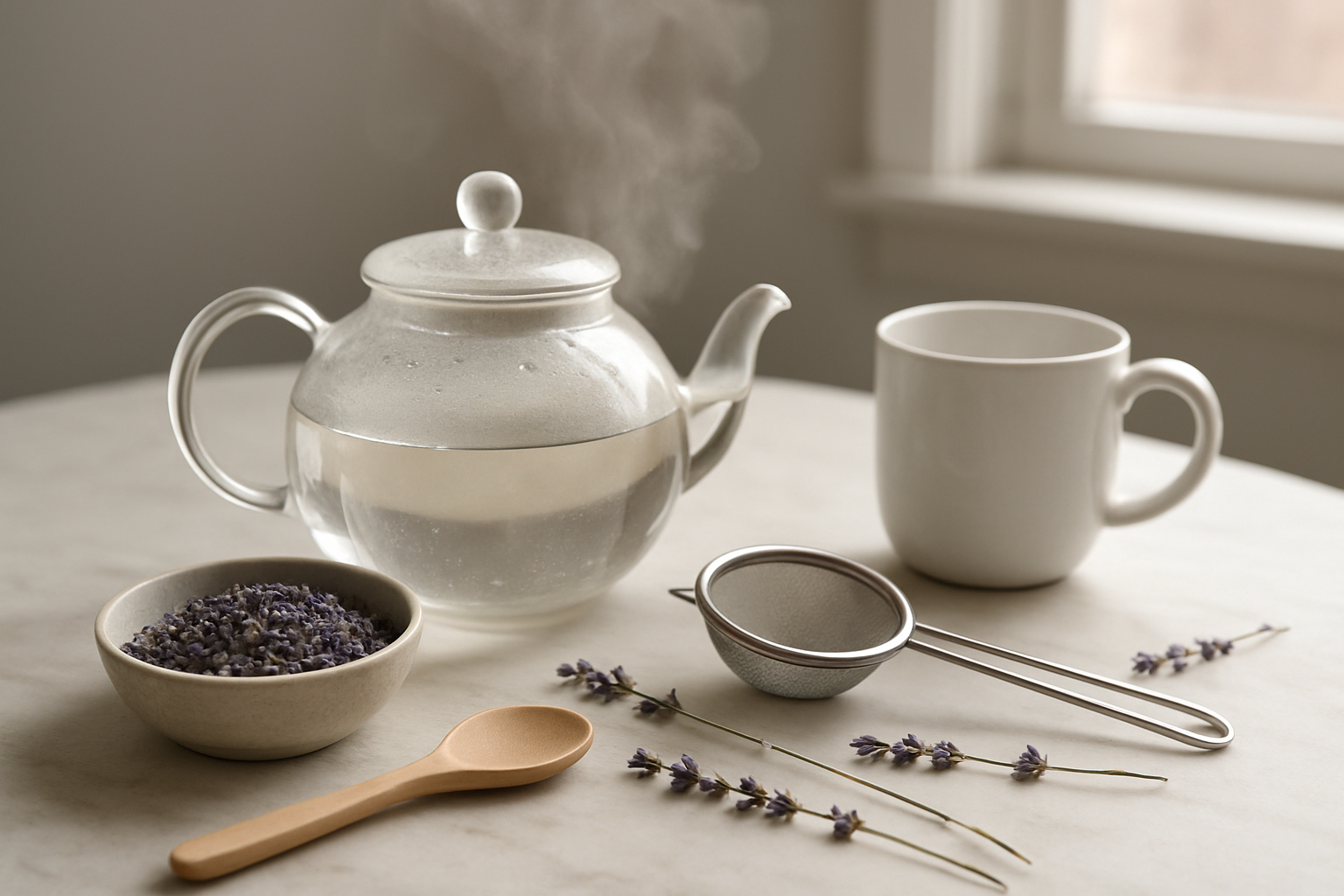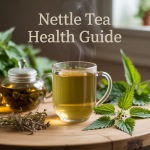Lavender tea has become a go-to wellness drink for people seeking natural ways to relax, sleep better, and support their overall health. This floral herbal tea offers impressive benefits backed by research, but like any wellness remedy, it comes with considerations you need to know about.
This guide is perfect for tea lovers, wellness enthusiasts, and anyone curious about adding lavender tea to their daily routine. We’ll explore the science-backed health benefits that make this purple flower so special for your mind and body. You’ll also learn about potential risks and safety tips to help you enjoy lavender tea responsibly. Finally, we’ll walk you through simple preparation methods and creative variations to make the perfect cup every time.
What Makes Lavender Tea a Powerful Wellness Drink

Natural compounds that create therapeutic effects
Lavender tea owes its wellness power to an impressive array of bioactive compounds that work together to promote relaxation and health. The star player is linalool, a terpene alcohol that makes up about 25-38% of lavender’s essential oil content. This compound directly influences your nervous system, binding to GABA receptors in the brain to create those signature calming effects you feel after sipping a warm cup.
Linalyl acetate, another key component comprising 25-45% of the essential oil, works alongside linalool to enhance the sedative properties. These two compounds create a synergistic effect that’s more powerful than either would be alone. Lavender also contains flavonoids like luteolin and apigenin, which act as natural antioxidants and help reduce inflammation throughout your body.
The flower heads contain rosmarinic acid, a phenolic compound that supports respiratory health and has antimicrobial properties. Camphor, present in smaller amounts, adds to the antiseptic qualities while contributing to lavender’s distinctive aroma. When these compounds are extracted through hot water steeping, they create a complex therapeutic blend that targets multiple body systems simultaneously.
Historical uses across different cultures
Ancient civilizations recognized lavender’s healing potential long before modern science could explain why it works. Egyptian pharaohs included lavender in their mummification process, believing it would provide protection in the afterlife. Archaeological evidence shows they also used lavender-infused waters for bathing and as perfume, recognizing its antibacterial properties.
Romans took lavender appreciation to new heights, literally naming the plant after their bathing rituals – “lavare” means “to wash” in Latin. They added lavender to their public baths and used it medicinally for everything from headaches to insomnia. Roman soldiers carried lavender with them on campaigns, using it to treat wounds and calm nerves before battle.
Medieval European monasteries cultivated extensive lavender gardens, with monks brewing lavender teas to treat anxiety, digestive issues, and sleep problems. During the plague years, people burned lavender in their homes and wore sachets, believing it would ward off disease – and they weren’t entirely wrong, given lavender’s antimicrobial properties.
Traditional Chinese Medicine incorporated lavender into formulas for “calming the spirit” and treating what they called “liver qi stagnation.” Persian and Arabian cultures used lavender tea for digestive complaints and as a general tonic for overall wellness.
Scientific research backing health claims
Modern research validates many traditional uses of lavender tea through rigorous clinical studies. A 2017 study published in the Journal of Alternative and Complementary Medicine found that participants who consumed lavender tea daily for two weeks showed significant improvements in sleep quality compared to the placebo group. Their sleep latency decreased by an average of 15 minutes, and they reported feeling more refreshed upon waking.
Anxiety reduction has been extensively studied, with multiple randomized controlled trials demonstrating lavender’s effectiveness. Research from 2019 in the International Journal of Psychiatry showed that lavender aromatherapy combined with oral consumption reduced anxiety scores by 32% in hospitalized patients. The calming effects typically begin within 30-45 minutes of consumption and can last up to 8 hours.
Pain management studies reveal promising results too. A 2020 clinical trial found that patients who drank lavender tea before medical procedures reported 23% less pain and required fewer pain medications. The anti-inflammatory compounds appear to work both locally and systemically to reduce pain perception.
Digestive health research shows lavender tea can reduce symptoms of irritable bowel syndrome and general stomach upset. The antispasmodic properties of linalool help relax smooth muscle in the digestive tract, while the anti-inflammatory compounds reduce gut inflammation. Studies indicate regular consumption may improve overall digestive comfort and reduce bloating.
Proven Health Benefits That Transform Your Well-Being

Reduces anxiety and promotes mental calmness
Lavender tea acts as nature’s anxiety reliever, working through multiple pathways to calm your nervous system. The key compound linalool directly affects your brain’s neurotransmitters, particularly GABA receptors, which help regulate mood and stress responses. When you drink lavender tea regularly, you’re essentially giving your brain a gentle nudge toward relaxation.
Clinical studies show that people who consume lavender tea experience measurable decreases in cortisol levels – your body’s primary stress hormone. This isn’t just about feeling better; your body actually shifts into a more balanced state. The aromatic compounds in lavender tea also trigger your olfactory system, sending calming signals to your limbic brain before you even finish your first sip.
Many people find that drinking lavender tea becomes a mindful ritual that enhances its anxiety-reducing effects. The act of brewing, inhaling the steam, and slowly sipping creates a natural pause in your day that helps break stress cycles.
Improves sleep quality and fights insomnia
Getting quality sleep becomes easier when lavender tea is part of your evening routine. The sedative properties of lavender compounds work by slowing down your nervous system activity, making it easier for your mind to transition from the day’s stresses to restful sleep.
Research demonstrates that lavender tea increases slow-wave sleep – the deep, restorative phase that leaves you feeling refreshed. People who struggle with racing thoughts at bedtime often find that lavender tea helps quiet their mental chatter, creating space for natural sleepiness to emerge.
The timing matters too. Drinking lavender tea about 30-45 minutes before bedtime allows the compounds to reach peak effectiveness right when you need them most. Unlike sleep medications that can leave you groggy, lavender tea promotes natural sleep patterns without morning side effects.
Supports digestive health and reduces bloating
Your digestive system responds positively to lavender tea’s antispasmodic properties, which help relax the smooth muscles in your intestinal tract. This relaxation reduces cramping, gas, and that uncomfortable feeling of fullness after meals.
Lavender tea also stimulates bile production, which improves your body’s ability to break down fats and process nutrients efficiently. When your digestion works smoothly, you experience less bloating and more consistent energy levels throughout the day.
The anti-inflammatory effects extend to your gut lining, helping reduce irritation that can contribute to digestive discomfort. Regular consumption may help establish better digestive patterns, especially for people who experience stress-related stomach issues.
Provides anti-inflammatory and antioxidant protection
The polyphenols and flavonoids in lavender tea act as powerful antioxidants, neutralizing free radicals that contribute to cellular aging and chronic inflammation. These compounds help protect your cells from oxidative stress that accumulates from daily environmental exposures and metabolic processes.
Lavender’s anti-inflammatory effects work systemically throughout your body, potentially reducing markers of inflammation in your blood. This protection may support cardiovascular health, joint comfort, and overall cellular function.
The antioxidant activity in lavender tea rivals that of green tea, offering similar protective benefits with a completely different flavor profile and additional calming properties that green tea doesn’t provide.
Potential Risks and Safety Considerations You Should Know

Drug interactions with medications
Lavender tea can interfere with several medications, making it crucial to consult your healthcare provider before adding it to your routine. The herb naturally contains compounds that may amplify the effects of sedative medications, including benzodiazepines, barbiturates, and sleep aids. This interaction can lead to excessive drowsiness, dizziness, or difficulty concentrating.
Blood pressure medications present another concern, as lavender’s natural calming properties may enhance their effects, potentially causing blood pressure to drop too low. People taking anticoagulant medications like warfarin should exercise caution, since some studies suggest lavender might affect blood clotting.
Anesthesia poses a particular risk – lavender can extend the sedative effects, so you should stop drinking lavender tea at least two weeks before any scheduled surgery. The herb may also interact with medications for anxiety and depression, potentially altering their effectiveness.
Allergic reactions and skin sensitivities
While rare, allergic reactions to lavender tea can range from mild to severe. Common symptoms include skin rashes, itching, hives, or redness around the mouth and throat area. Some people experience digestive upset, including nausea, stomach pain, or diarrhea.
More serious reactions might involve difficulty breathing, swelling of the face, lips, or tongue, and chest tightness. These symptoms require immediate medical attention. People with existing allergies to other plants in the mint family, such as rosemary, sage, or oregano, face higher risks of lavender sensitivity.
Topical sensitivity can also develop from drinking lavender tea regularly. Some individuals notice increased skin reactions when exposed to lavender-scented products after consuming the tea frequently.
Pregnancy and breastfeeding precautions
Pregnant and breastfeeding women should approach lavender tea with extra caution. While small amounts used occasionally in cooking are generally considered safe, the concentrated amounts found in medicinal teas haven’t been thoroughly studied for safety during pregnancy.
Lavender contains compounds that might stimulate uterine contractions, potentially increasing miscarriage risk during early pregnancy. The herb could also affect hormone levels, which pregnant women need to maintain careful balance.
For breastfeeding mothers, lavender compounds can pass through breast milk to the baby. Since infants’ developing systems can’t process these compounds as efficiently as adults, even small amounts might cause digestive issues or excessive sleepiness in nursing babies.
Dosage limits to avoid adverse effects
Sticking to appropriate dosage limits helps minimize risks while enjoying lavender tea’s benefits. Most experts recommend limiting consumption to 1-2 cups per day, using about 1 teaspoon of dried lavender buds per cup of water.
Drinking more than 3 cups daily may lead to headaches, constipation, or increased appetite. Some people report feeling overly drowsy or mentally foggy when consuming large amounts regularly.
Children should consume significantly smaller amounts – no more than half a cup of weak lavender tea, and only occasionally. Their developing systems process herbs differently than adults, making them more susceptible to adverse effects.
Starting with small amounts allows you to gauge your body’s response. Begin with half a cup every few days, then gradually increase if you don’t experience any negative reactions. Keep a simple log of how much you drink and any symptoms you notice.
Simple Steps to Prepare Perfect Lavender Tea at Home

Choosing High-Quality Dried Lavender Buds
Quality makes all the difference when brewing lavender tea. Look for organic, food-grade lavender buds that appear deep purple with intact flower heads. The buds should release a strong, sweet fragrance when gently crushed between your fingers. Avoid any lavender that looks brown, dusty, or lacks aroma – these signs indicate old or poor-quality flowers.
Culinary lavender (Lavandula angustifolia) works best for tea, as it has a sweeter, more delicate flavor compared to other varieties. You can find high-quality dried lavender at specialty tea shops, health food stores, or reputable online retailers. Always check that the packaging clearly states “food grade” or “culinary use.”
Store your lavender buds in an airtight container away from direct sunlight. Properly stored lavender maintains its potency for up to two years, though fresher is always better for the most vibrant flavor and maximum therapeutic benefits.
Proper Water Temperature and Steeping Techniques
Water temperature plays a crucial role in extracting lavender’s beneficial compounds without creating a bitter taste. Heat your water to 200-212°F (93-100°C) – just at the boiling point. If you don’t have a thermometer, bring water to a rolling boil, then let it sit for 30 seconds before pouring.
Use filtered or spring water when possible, as chlorinated tap water can interfere with the delicate floral notes. The ideal water-to-lavender ratio is 8 ounces of water to 1 teaspoon of dried lavender buds. For a stronger brew, add more lavender rather than increasing steeping time.
Pour the hot water directly over the lavender buds in your teapot or cup. Cover immediately to prevent the essential oils from escaping through steam. This step traps the aromatic compounds that provide both flavor and therapeutic benefits.
Ideal Brewing Time for Maximum Benefits
Steeping time determines both flavor intensity and the extraction of beneficial compounds. For most people, 5-10 minutes creates the perfect balance. Start with 5 minutes for a mild, floral taste, or extend to 10 minutes for a more robust flavor with enhanced therapeutic properties.
Steeping longer than 10 minutes can result in an overly strong, potentially bitter tea that may cause drowsiness in sensitive individuals. If you prefer stronger tea, use more lavender buds rather than extending the brewing time.
Strain the tea through a fine-mesh strainer or remove tea bags before drinking. The finished tea should have a light purple hue and a pleasant floral aroma. You can enjoy it hot or let it cool for a refreshing iced version. Add honey, lemon, or mint to complement the lavender’s natural sweetness.
Creative Variations to Enhance Your Tea Experience

Blending with complementary herbs and spices
Combining lavender with other herbs creates symphony-like flavor profiles that can transform your tea ritual. Chamomile pairs beautifully with lavender, amplifying the calming effects while adding a gentle apple-like sweetness. The combination works particularly well for bedtime teas, as both herbs promote relaxation and better sleep quality.
Mint varieties, especially spearmint and peppermint, bring refreshing brightness to lavender’s floral depth. This pairing creates an invigorating yet soothing experience that works wonderfully as an afternoon pick-me-up. For digestive support, try blending lavender with ginger and fennel seeds – the warming spices balance lavender’s coolness while creating a comforting stomach-settling brew.
Rose petals create an elegant floral bouquet when mixed with lavender, perfect for special occasions or self-care moments. Add a pinch of cardamom pods for exotic warmth, or include orange peel for citrusy brightness. Lemon balm brings lemony freshness that cuts through lavender’s intensity, making it more approachable for those new to floral teas.
For immune-supporting blends, combine lavender with echinacea and elderberries. The purple theme isn’t just visually appealing – these ingredients work together to support overall wellness. Holy basil (tulsi) adds adaptogenic properties while complementing lavender’s stress-reducing benefits, creating a powerhouse blend for managing daily tensions.
Adding natural sweeteners and flavor enhancers
Raw honey stands as the classic companion to lavender tea, its floral notes harmonizing perfectly with lavender’s botanical essence. Local honey adds regional terroir while providing antimicrobial benefits that complement lavender’s healing properties. Choose lighter varieties like clover or wildflower honey to avoid overpowering the delicate lavender flavor.
Maple syrup offers rich, caramel-like sweetness that creates depth in lavender tea. Grade A Dark maple syrup works particularly well, adding complexity without masking the floral notes. For a lighter touch, Grade A Golden provides subtle sweetness that enhances rather than dominates.
Coconut sugar brings tropical warmth and slight caramel notes that pair surprisingly well with lavender’s Mediterranean character. Stevia works for those avoiding calories, but use sparingly as too much can create bitter aftertastes that clash with lavender’s delicate profile.
Citrus additions brighten lavender tea dramatically. Fresh lemon juice adds tartness that balances floral intensity, while orange zest contributes aromatic oils that complement lavender’s essential oil compounds. Lime zest creates unexpected tropical notes that work especially well in iced preparations.
Vanilla extract or vanilla bean paste adds creamy sweetness that transforms lavender tea into a dessert-like experience. Use pure vanilla extract rather than imitation versions for the best flavor integration. A few drops go a long way in creating a luxurious, bakery-inspired taste profile.
Hot versus cold brewing methods
Hot brewing remains the traditional method for extracting lavender’s full aromatic potential. Water temperature matters significantly – aim for 200°F rather than full boiling to prevent extracting bitter compounds from the delicate flowers. Steep dried lavender for 3-5 minutes, tasting at the 3-minute mark to gauge strength preference. Longer steeping times can create overly potent, soap-like flavors that overwhelm rather than soothe.
Cover your teapot or cup while steeping to trap the volatile oils that give lavender tea its therapeutic aromatherapy benefits. The steam carries essential compounds that contribute to the relaxation response even before you take your first sip.
Cold brewing creates an entirely different lavender tea experience, producing smoother, less astringent flavors with natural sweetness that hot brewing sometimes masks. Use a 1:4 ratio of lavender to cold water, steeping in the refrigerator for 6-8 hours. This method extracts fewer tannins while preserving delicate floral compounds that heat can diminish.
Cold-brewed lavender tea works exceptionally well as a base for summer beverages. Add sparkling water for a refreshing lavender soda, or freeze into ice cubes for gradually flavoring other beverages. The concentrated cold brew can be diluted with hot water for instant hot tea, giving you versatility from a single preparation.
Sun tea represents a middle-ground approach, using gentle solar heating to extract flavors slowly. Place lavender in a glass jar with room-temperature water and leave in direct sunlight for 2-4 hours. This method creates complex flavors while maintaining the bright, fresh characteristics that make lavender tea so appealing.

Lavender tea offers a remarkable blend of relaxation and wellness benefits that can genuinely improve your daily routine. From reducing anxiety and promoting better sleep to supporting digestive health, this fragrant herbal tea has earned its place as a natural remedy worth trying. The gentle nature of lavender makes it accessible to most people, though staying mindful of proper dosage and potential interactions keeps your tea experience both safe and enjoyable.
Making lavender tea at home is surprisingly simple and opens up endless possibilities for customization. Whether you prefer a classic cup before bedtime or want to experiment with honey, lemon, or other herbs, you can easily tailor this soothing drink to match your taste preferences. Give lavender tea a try for a few weeks and notice how this small change might help you unwind, sleep better, and feel more balanced throughout your day.














